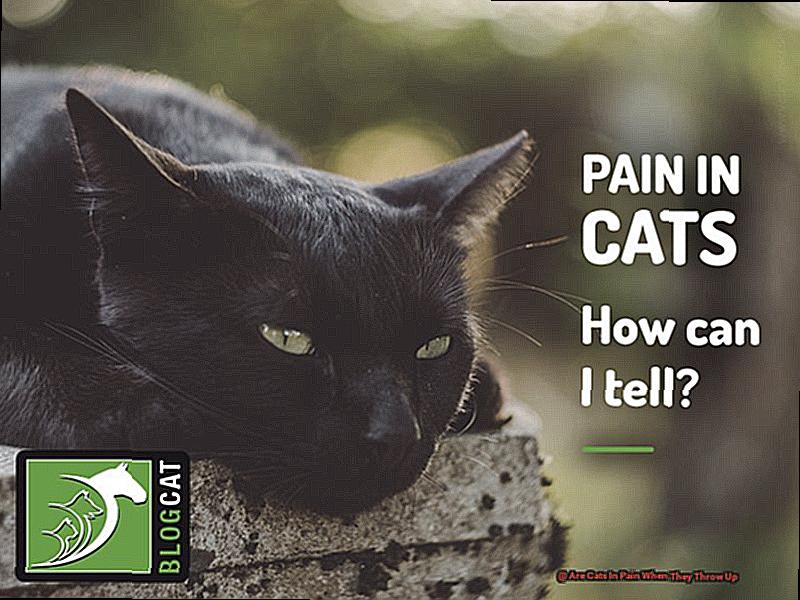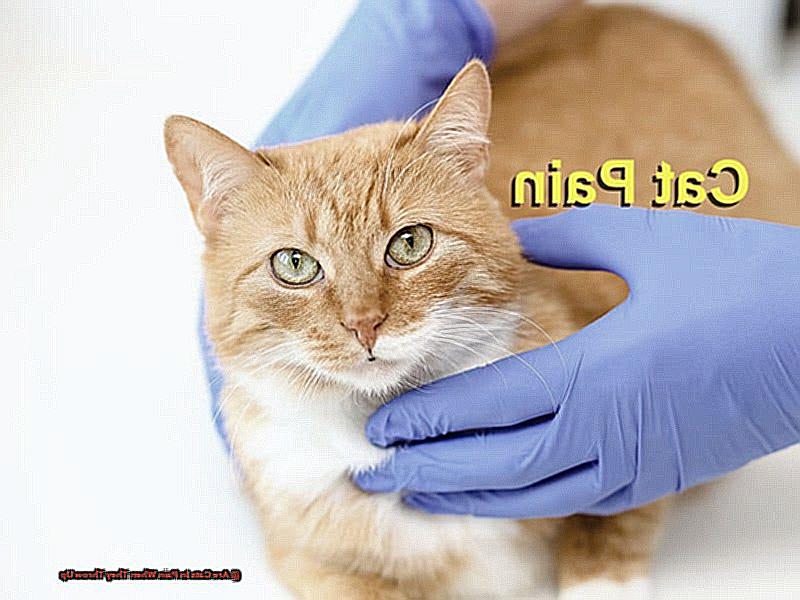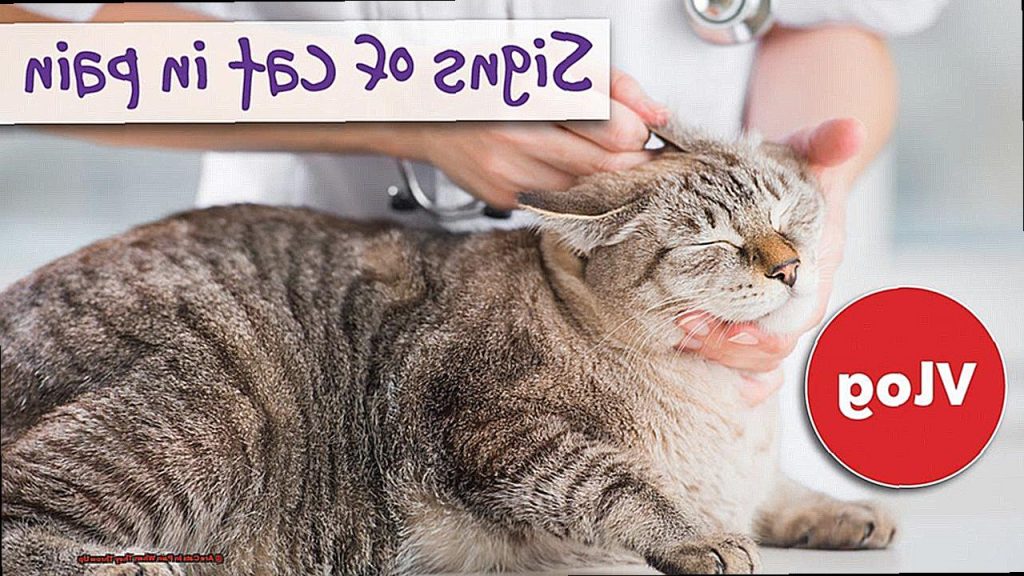Cats are known for their elegant and independent nature, but when it comes to throwing up, they can be anything but poised.
As a cat parent, you’ve probably witnessed your furry pal hunched over and heaving out a hairball or some mystery substance. But have you ever wondered if this unpleasant experience causes them pain?
After all, vomiting can be uncomfortable and may even indicate underlying health issues. In this post, we’ll delve into the world of feline anatomy to uncover the truth about whether our beloved kitties truly feel pain when they toss their cookies.
So, snuggle up with your furry friend and let’s find out if cats suffer when they vomit.
Are Cats In Pain When They Throw Up?
Contents
The answer is not always straightforward.
Firstly, it’s important to understand that vomiting is not always an indication of pain. Sometimes, cats throw up because they have ingested too much hair, grass, or food, and they need to expel it from their stomachs. This is considered a normal and healthy behavior for cats, and it usually does not cause them any discomfort.
However, vomiting can also be a sign of an underlying medical condition, such as kidney disease, pancreatitis, intestinal obstruction, or poisoning. In these cases, cats may experience pain, nausea, or other symptoms that affect their well-being. Some signs that your cat may be in pain when they throw up are:
- Vomiting frequently or persistently
- Vomiting blood or bile
- Having diarrhea or constipation
- Losing appetite or weight
- Showing signs of dehydration
- Being lethargic or depressed
- Hiding or avoiding contact
- Vocalizing or crying
- Having difficulty breathing or swallowing
If you notice any of these signs in your cat, you should consult your veterinarian as soon as possible. They can diagnose the cause of your cat’s vomiting and provide the appropriate treatment and pain relief. Your cat may need medication, fluids, surgery, or dietary changes, depending on the severity and nature of their condition.
Causes of Vomiting in Cats
Vomiting is a natural reflex that helps cats get rid of any unwanted substances in their stomachs. It differs from regurgitation, which happens when food is brought back up without any abdominal effort. While vomiting can be a common occurrence in cats, it’s important to pay attention to the frequency and underlying causes of this behavior.
Common Causes of Vomiting in Cats
Hairballs
Cats are known for their grooming habits, and while this is generally beneficial for their health, it can also lead to hairballs. When cats groom themselves, they ingest loose hair which can accumulate in their digestive system and form a hairball. This can cause irritation and discomfort, leading to vomiting.
Dietary Indiscretion
Just like humans, cats can have a sensitive stomach and may not react well to certain foods. They may also be tempted to eat things they shouldn’t, such as plants or spoiled food, which can upset their stomachs and cause vomiting.
Food Allergies
Some cats may have allergies to certain ingredients in their food, leading to digestive issues and vomiting. If you suspect your cat has a food allergy, consult with your veterinarian to determine the best diet for them.
Intestinal Parasites
Worms and other parasites can also cause vomiting in cats. These unwanted guests can irritate the lining of the stomach and intestines, leading to nausea and vomiting.
Ingestion of Foreign Objects
Cats are curious creatures and may ingest objects that can irritate their stomachs, such as string or small toys. These foreign objects can cause blockages or irritation, leading to vomiting.
More Serious Causes of Vomiting in Cats
While most cases of vomiting in cats are not serious, there are some conditions that may require immediate veterinary attention. These include:
Inflammatory Bowel Disease (IBD)
This condition causes inflammation of the digestive tract and can lead to chronic vomiting in cats. It’s important to consult with your veterinarian for proper diagnosis and treatment.
Kidney Disease
Cats with kidney disease may experience nausea and vomiting as a result of their compromised kidney function. If your cat is vomiting frequently, it’s important to have them checked for kidney disease.
Pancreatitis
Inflammation of the pancreas can cause vomiting in cats. This condition can be painful, and your cat may vocalize or show signs of distress while vomiting.
Do Cats Experience Pain When Throwing Up?
If you’ve ever had a feline companion, you know that cats are masters at hiding their pain and discomfort. As pet owners, it can be challenging to determine if our furry friends are experiencing pain, especially when they throw up. So, do cats experience pain when throwing up?
The short answer is yes, they can. Vomiting in cats can be a painful experience due to various reasons, such as hairballs, gastrointestinal diseases, and even cancer. In this blog post, we’ll explore the potential link between vomiting and pain in cats and provide tips for identifying signs of discomfort during vomiting.
The Connection Between Throwing Up and Pain in Cats
Vomiting is a natural reflex in cats designed to rid the body of harmful substances or irritants. However, the forceful contraction of abdominal muscles during vomiting can cause discomfort for our feline companions. Additionally, the irritation and inflammation of the esophagus from stomach acid can also contribute to their pain.
According to studies, a significant percentage of cats experience pain during vomiting episodes. In a study published in the Journal of Feline Medicine and Surgery, 45% of cats showed signs of pain during vomiting. Another study published in the Journal of Veterinary Pharmacology and Therapeutics found that 83% of cats experienced abdominal discomfort during vomiting.
Common Causes of Vomiting and Potential Pain Associated with Them
Now that we know cats can experience pain when throwing up let’s take a look at some common causes of vomiting and how they may contribute to their discomfort.
- Hairballs – It’s no secret that cats are meticulous groomers, which often leads to hairballs. While hairballs are not usually harmful, they can cause discomfort and pain when trying to pass through the digestive system.
- Gastrointestinal Diseases – Conditions like gastritis, inflammatory bowel disease, or foreign body ingestion can cause severe abdominal pain in cats when they vomit.
- Pancreatitis – Inflammation of the pancreas can lead to abdominal pain and nausea, making vomiting a painful experience for cats.
- Kidney Disease – Vomiting can be a sign of kidney disease in cats, which can also cause abdominal pain and discomfort.
- Cancer – Unfortunately, tumors in the digestive system or other organs can cause pain in cats when they vomit.
Signs of Pain During Vomiting
We never want to see our furry companions in pain. Unfortunately, cats are experts at masking their discomfort and it can be challenging to tell when they are experiencing pain. One common sign that may indicate your cat is in pain is their behavior during vomiting. In this section, we will discuss the various signs that can indicate your cat may be experiencing pain while vomiting.

Vocalization
Cats are known for their meows and purrs, but did you know that vocalization during vomiting could be a sign of pain? If your cat is meowing or yowling loudly while throwing up, it could be a signal that they are in discomfort. This could be due to the act of vomiting itself causing pain in their throat or stomach.
Body Position
When a cat is in pain, they may exhibit certain body positions that can give us clues about their discomfort. If your cat is hunched over, trembling or shaking, or holding their head low to the ground while vomiting, it could be a sign that they are experiencing pain. These positions may indicate that the act of vomiting is causing them discomfort.
Distress Behaviors
Another indicator of pain during vomiting is distress behaviors. If your cat is pacing, panting, or excessively grooming themselves after throwing up, it could be a sign that they are experiencing pain. These behaviors are their way of trying to cope with the discomfort.
Breathing Patterns
Pay attention to your cat’s breathing patterns during vomiting. If they are breathing rapidly or heavily, it could be a sign that they are in pain. The act of vomiting can put strain on their respiratory system, causing them to breathe faster or heavier than usual.
Avoidance of Eating or Drinking
After a vomiting episode, you may notice that your cat avoids eating or drinking. This could be a sign that they are experiencing pain in their digestive system. It’s important to monitor their food and water intake after vomiting and consult with your veterinarian if they continue to avoid eating or drinking.
Blood in Vomit
While it is not common, the presence of blood in vomit can be a sign of underlying health issues that may cause pain during vomiting. If you notice blood in your cat’s vomit, it is important to seek veterinary attention immediately.
Frequency and Severity of Vomiting in Cats
As cat owners, we all want our furry friends to be happy and healthy. But what happens when your cat starts vomiting? It can be a worrying sight, especially if it happens frequently or seems severe. As an expert on the topic of “Frequency and Severity of Vomiting in Cats,” let me share with you the importance of monitoring these factors for your cat’s well-being.
Why Do Cats Vomit?
Firstly, let’s understand why cats vomit. Vomiting is a natural defense mechanism for cats, and it can occur for various reasons. It could be due to ingestion of hairballs, overeating, or eating something that doesn’t agree with their stomach. However, it can also be a sign of an underlying health issue such as gastrointestinal problems, infections, or even stress.
Frequency of Vomiting
Cats are known to have a sensitive digestive system, which makes them more prone to vomiting compared to dogs. However, occasional vomiting (once or twice a month) is considered normal for cats. It could be due to their grooming habits, which often leads to them ingesting hairballs.
But if you start noticing your cat vomiting more than twice a week, it could indicate a digestive problem or another underlying issue. This is where monitoring the frequency of your cat’s vomiting comes into play. Keep track of how often your cat vomits and take note if there are any changes or patterns.
Severity of Vomiting
Vomiting can also vary in severity, from mild regurgitation to forceful expulsion of food and fluids. The severity of vomiting can also indicate the level of discomfort or pain your cat may be experiencing. If your cat is struggling to vomit or seems in pain while throwing up, it could be a sign of an underlying issue that needs medical attention.
Other Factors to Consider
Apart from the frequency and severity of vomiting, there are other factors that can contribute to this issue in cats. These include diet, stress levels, and the presence of parasites or foreign objects in the digestive tract. Therefore, it is crucial to pay attention to your cat’s overall health and well-being and consult with a veterinarian if you notice any changes or concerns.
Other Indicators of Pain in Cats
While occasional vomiting may not be a cause for concern, it is important to monitor for other signs of pain and discomfort when your cat is throwing up. Here are some other indicators to look out for:
Changes in Behavior
Cats are notorious for hiding their pain, making it difficult for us to know when they are experiencing discomfort. However, when they are throwing up, they may exhibit other changes in behavior that can signal pain. This can include vocalizing or crying out, excessive drooling, and changes in mood or behavior.
Hunched Posture
Have you noticed your cat curling up tightly or tucking their head down towards their stomach while vomiting? This hunched posture is often a protective response to abdominal pain and can be seen in cats who are experiencing discomfort during vomiting episodes.
Lethargy and Loss of Appetite
After throwing up, cats may become more lethargic and refuse to eat. These are common signs of pain and should not be ignored. Keep an eye on your cat’s energy levels and eating habits to determine if there is an underlying issue causing their vomiting.
Aggression or Irritability
Some cats may also become more aggressive or irritable when they are in pain. If you notice your usually calm and friendly cat suddenly lashing out or acting out of character after vomiting, it could be a sign of discomfort.

Changes in Litter Box Habits
Monitoring your cat’s litter box habits is crucial when they are experiencing vomiting episodes. Any changes in frequency or appearance of bowel movements can indicate underlying health issues that may be causing the vomiting and potential pain for your cat.
Vomiting Blood
While not always the case, vomiting blood or having blood in their stool can be a serious indicator of pain in cats. If you notice any blood in your cat’s vomit or stool, it is important to seek medical attention immediately.
Addressing Potential Health Issues Causing Vomiting
As cat owners, we all know that occasional vomiting is a normal part of our furry friend’s life. But when does it become a cause for concern? One key factor to consider is whether or not your cat is experiencing pain while vomiting. In this section, we will discuss how identifying and addressing potential health issues can help determine if your cat is in pain during vomiting.
Not all vomiting in cats indicates pain.
First and foremost, it is essential to note that not all vomiting episodes in cats indicate pain. Sometimes, it can be a natural way for cats to expel hairballs or undigested food. However, if your cat is frequently throwing up or seems to be in discomfort while doing so, it could be a sign of an underlying health issue.
Common health issues that can cause pain while vomiting.
Some common health issues that can cause vomiting in cats include pancreatitis, kidney disease, intestinal blockages, and even cancer. These conditions may cause abdominal pain and discomfort, which your cat may express during vomiting episodes.
Medication and anesthesia as potential causes of pain.
If your cat has recently undergone surgery or is taking medication for a health issue, it is crucial to consult with your veterinarian about the potential side effects. Some medications or anesthesia may cause stomach irritation or discomfort, leading to pain while vomiting.
How esophagitis can lead to pain during vomiting.
Esophagitis, inflammation of the esophagus, can also cause pain during vomiting in cats. This condition can occur due to acid reflux or ingestion of a foreign object. Cats with esophagitis may show signs of difficulty swallowing, loss of appetite, and pain while vomiting.
Conclusion
In conclusion, despite their reputation for being graceful and self-sufficient creatures, cats are not immune to the unpleasant sensation of vomiting. As responsible pet owners, it is crucial to pay attention to our feline friends’ behavior during these episodes and be aware of any signs of pain or discomfort.
While not all instances of vomiting in cats indicate pain, it is important to remain vigilant and consider possible underlying health issues that may cause discomfort during this natural reflex. These can range from hairballs and gastrointestinal disorders to more serious conditions like kidney disease or cancer. Additionally, certain medications or anesthesia can also contribute to stomach irritation and pain while vomiting.
If you notice your cat exhibiting signs of pain such as vocalization, a hunched posture, or changes in behavior after throwing up, it is imperative to seek guidance from your veterinarian. They can help identify the root cause of your cat’s discomfort and provide appropriate treatment.
To summarize, while vomiting may not be a pleasant experience for our furry companions, by being attentive and addressing any potential health concerns causing their distress, we can ensure their overall well-being and keep them content and healthy.






